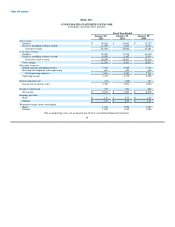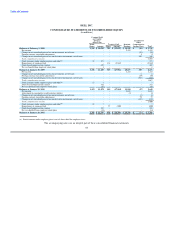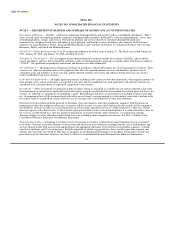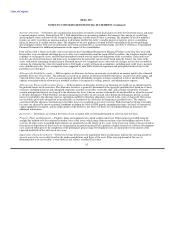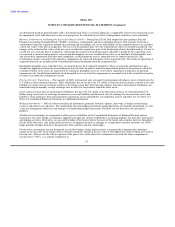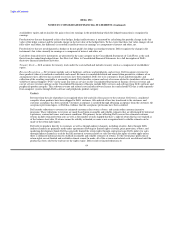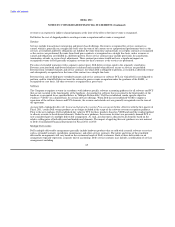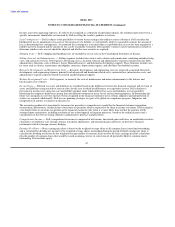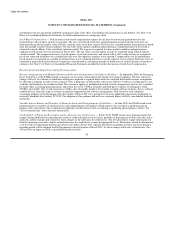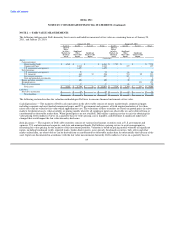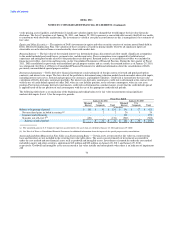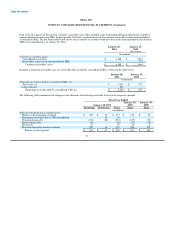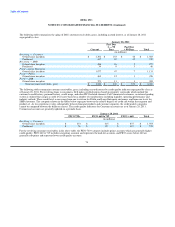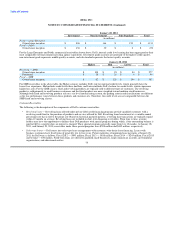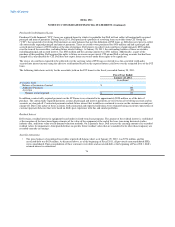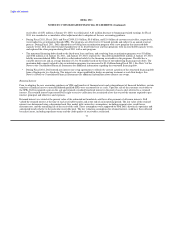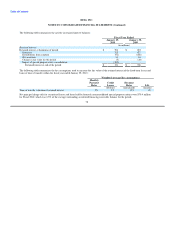Dell 2010 Annual Report Download - page 72
Download and view the complete annual report
Please find page 72 of the 2010 Dell annual report below. You can navigate through the pages in the report by either clicking on the pages listed below, or by using the keyword search tool below to find specific information within the annual report.
Table of Contents
DELL INC.
NOTES TO CONSOLIDATED FINANCIAL STATEMENTS (Continued)
instruments from the calculation of diluted earnings per share if the effect of including such instruments is anti-dilutive. See Note 13 of
Notes to Consolidated Financial Statements for further information on earnings per share.
Stock-Based Compensation — Dell measures stock-based compensation expense for all share-based awards granted based on the
estimated fair value of those awards at grant-date. The cost of restricted stock units and performance-based restricted stock units are
determined using the fair market value of Dell's common stock on the date of grant. Dell also has a limited number of performance-based
units that include a market-based condition. The fair value of the market-condition and performance-condition portion of the award is
estimated using the Monte Carlo simulation valuation model. The expense recognized for these market-condition and performance-
condition based awards were not material for Fiscal 2011. The fair values of stock option awards are estimated using a Black-Scholes
valuation model. The compensation costs of stock options, restricted stock units, and awards with a cliff vesting feature are recognized
net of any estimated forfeitures on a straight-line basis over the employee requisite service period. Compensation cost for performance
based awards is recognized on a graded accelerated basis net of estimated forfeitures over the requisite service period. Forfeiture rates are
estimated at grant date based on historical experience and adjusted in subsequent periods for differences in actual forfeitures from those
estimates. See Note 15 of Notes to Consolidated Financial Statements included for further discussion of stock-based compensation.
Recently Issued and Adopted Accounting Pronouncements
Revenue Arrangements with Multiple Elements and Revenue Arrangements with Software Elements — In September 2009, the Emerging
Issues Task Force of the FASB reached a consensus on two issues which affects the timing of revenue recognition. The first consensus
changes the level of evidence of standalone selling price required to separate deliverables in a multiple deliverable revenue arrangement
by allowing a company to make its best estimate of the selling price of deliverables when more objective evidence of selling price is not
available and eliminates the residual method. The consensus applies to multiple deliverable revenue arrangements that are not accounted
for under other accounting pronouncements and retains the use of VSOE if available and third-party evidence of selling price when
VSOE is unavailable. The second consensus excludes sales of tangible products that contain essential software elements, that is, software
enabled devices, from the scope of revenue recognition requirements for software arrangements. Dell elected to early adopt this
accounting guidance at the beginning of the first quarter of Fiscal 2011 on a prospective basis for applicable transactions originating or
materially modified after January 29, 2010. The adoption of this guidance did not have a material impact to Dell's consolidated financial
statements.
Variable Interest Entities and Transfers of Financial Assets and Extinguishments of Liabilities — In June 2009, the FASB issued a new
pronouncement on transfers of financial assets and extinguishments of liabilities which removes the concept of a qualifying special
purpose entity and removes the exception from applying variable interest entity accounting to qualifying special purpose entities. See
"Asset Securitization" above for more information.
Credit Quality of Financing Receivables and the Allowance for Credit Losses — In July 2010, FASB issued a new pronouncement that
requires enhanced disclosures regarding the nature of credit risk inherent in an entity's portfolio of financing receivables, how that risk is
analyzed, and the changes and reasons for those changes in the allowance for credit losses. The new disclosures require information for
both the financing receivables and the related allowance for credit losses at more disaggregated levels. Disclosures related to information
as of the end of a reporting period became effective for Dell in Fiscal 2011. Specific disclosures regarding activities that occur during a
reporting period will be required for Dell beginning in the first quarter of Fiscal 2012. As these changes relate only to disclosures, they
will not have an impact on Dell's consolidated financial results.
68


